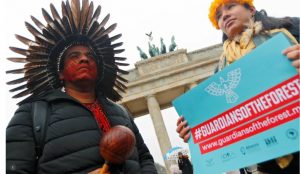
“A decade ago this land was dismissed as lost to the desert,” said ecologist Mamadou Diakite. He was smiling beneath the shade of a tree, one of hundreds growing vigorously all around him on land previously abandoned by local millet farmers.
The growth of these trees, and hundreds of millions more in a remote region of West Africa on the edge of the Sahara desert, is the result of local farmers abandoning long-standing advice from government experts to uproot trees on their fields – and to nurture them instead.
What is today called “Farmer-Managed Natural Regeneration” is thought to have begun in the mid-1980s in Dan Saga, a village in the Maradi region of Niger, which suffered hugely from Sahel droughts in the 1970s.
The story is that some young men returned to their fields late in the season after working abroad. In a rush, they planted their crops without first clearing their land of woody plants. To their surprise, their grain yields were better than in neighbouring fields that had been cleared. When the same thing happened the next year, the village got the message: Trees were good for their crops.
So from then on, when preparing their land for planting, farmers cultivated stems growing from stumps in their fields. The resulting trees fixed nitrogen, stabilised soils and dropped leaves that maintained soil moisture.
And before long, the trees were providing firewood, animal fodder and other products, as well as shading crops and villages from wind and sun. The message spread. “It was slow to take off, but now they all want to do it,” Diakite said. “The land is coming back into production.”
This version of agroforestry has now extended across 5 million hectares of Niger. The 200 million extra trees benefit yields of millet and sorghum on more than a million farms, which typically gain an income of about $1,000 per year from selling products such as wood, fodder, fruit, pods and leaves.
And there is another, less immediately tangible benefit: The trees capture an estimated 30 million tonnes of carbon from the atmosphere.
Niger’s grassroots revolution – which for a long time was invisible to outsiders – is not an isolated example of people bringing back diverse forests, but has been replicated in different forms in different corners of the globe – from once denuded farmlands in Costa Rica to the foothills of the Himalayas, from the remote Scottish coast to the Xingu basin in the Amazon, and elsewhere.
Click here for the full story.
Originally published on News Trust.




